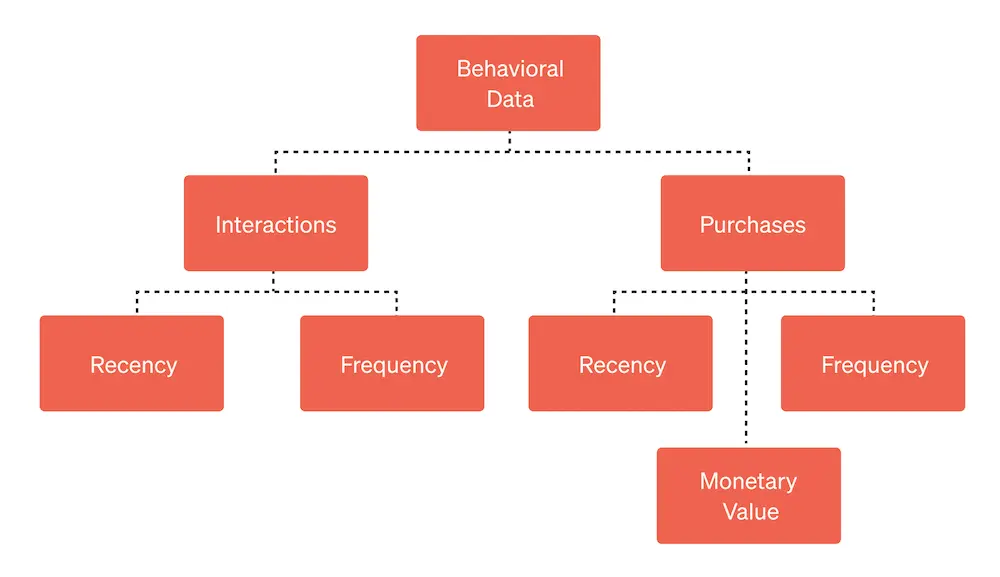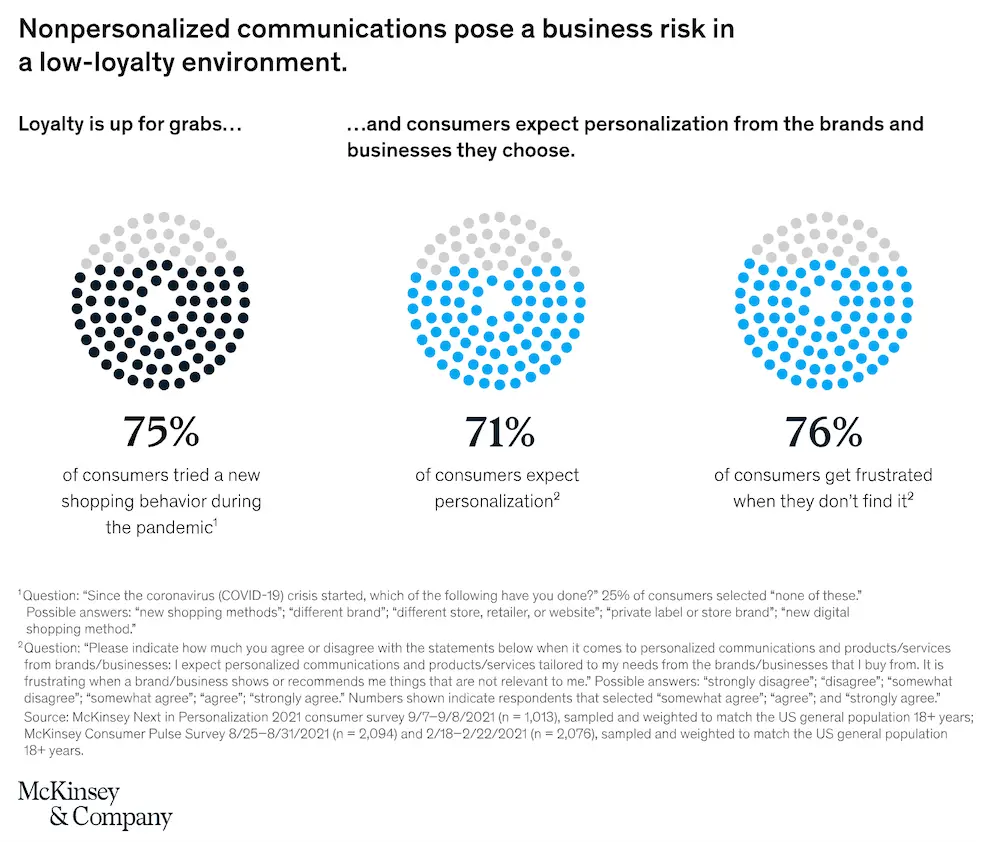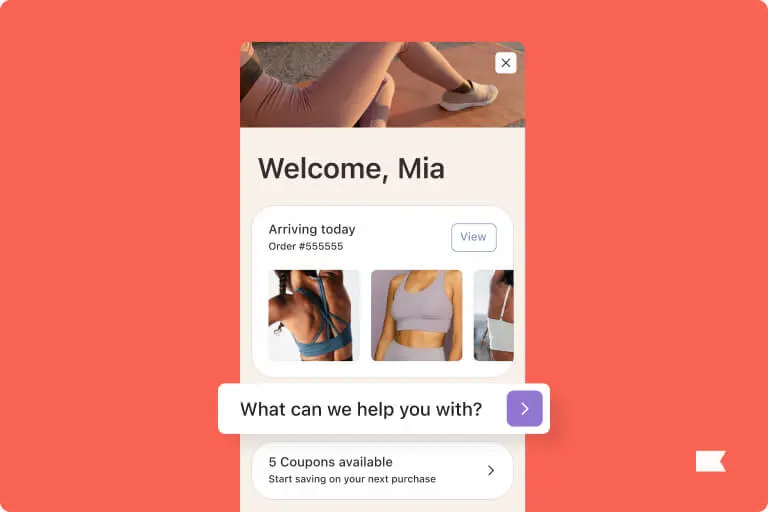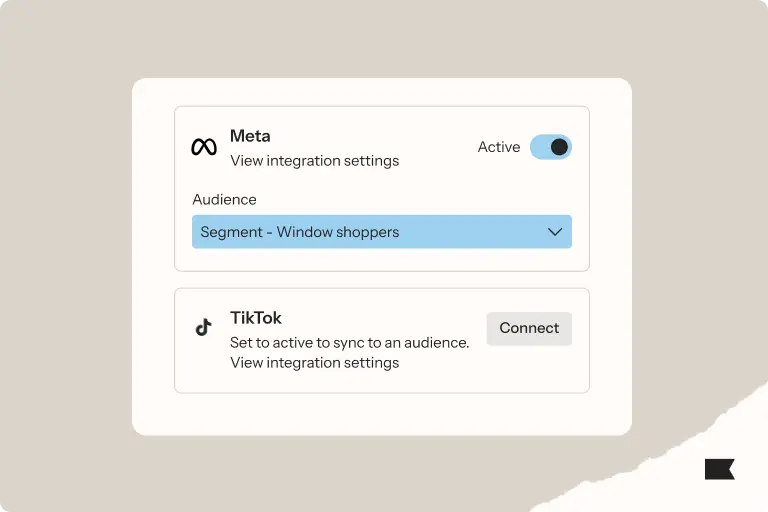What is behavioral targeting? Here’s how it works—and how to avoid the “Big Brother” factor

If someone places an order in your online store, it’s logical to follow up with them to encourage another purchase.
But when do you follow up? With what messaging? And on what channel?
Answering those questions, says Jon Palmer, lead product marketing manager at Klaviyo, requires achieving a holistic, 360-degree view of not only the customer in question, but all of your other customers, subscribers, and potential customers as well—and that means that simply knowing someone placed an order “is not enough,” he says.
“What SKU did they buy? When does the typical customer of that SKU go from purchase 1 to purchase 2? And based on this individual’s level of onsite activity, email engagement and average order size, when are they likely to purchase again?”
Ideally, Palmer adds, “you have AI feeding into it, too. So it’s not just historical data, but also what someone is likely to do in the future based on what they’ve done in the past. And other people like them, too.”
It’s a lot to consider—and it’s all part of how behavioral targeting works.
What is behavioral targeting?
Behavioral targeting is a form of personalized marketing in which the recent and historical activities of your subscribers, website visitors, or customers determine the kind of messaging you send them next.
Together, these behavioral data points leave a unique trail of breadcrumbs your brand can scoop up and use to sort people into different categories, or audience segments—making it easier for you to send timely, tailored marketing messages to your target audience.
Note that the key word there is “together,” Palmer says: “Behavioral targeting means taking the entirety of customer behavior, and personalizing communication based on that.”
What Palmer means by “entirety of customer behavior” is all touchpoints. The words or phrases someone types into your site search, the pages they view most frequently, where they spend the most time on your site and mobile app, what they click on in emails and texts, their in-store and online purchase behavior, activity in your loyalty or rewards program—“the whole thing,” he says.

Behavioral targeting vs. contextual targeting
Contextual targeting aligns advertising with the webpages on which those ads appear, which makes it less personalized than behavioral targeting. Applicable in the realm of paid retargeting ads, it focuses on the similarities between content and shows shoppers relevant ads on contextually similar sites within the Google Display Network.
The main difference between contextual and behavioral advertising, then, is that contextual advertising is less precise. Whereas contextual targeting creates an ad experience based on where “best-fit” potential customers are likely to browse, behavioral targeting is about crafting a personalized customer experience based on the actual user data you’ve collected—not assumptions you make based on where they’ve landed around the web.
Is behavioral targeting ethical? Hint: it depends on your data
We’ve all had that moment after having a casual conversation when we open our phones, start scrolling, and immediately see an advertisement for the exact thing we were just talking about.
Blame it on the dark side of behavioral targeting.
At its best, behavioral targeting has the power to bring shoppers back to your store, get them to engage with your content, and convince them to take whatever action you most want them to take—driving higher user engagement, conversion rates, and marketing return on investment (more next on the benefits of behavioral targeting).
We don’t want to creep anybody out.
But at its worst, it can cross boundaries many consumers hold sacred.
As marketers continue to adjust the way they learn about and communicate with their customers in the wake of Apple’s iOS privacy updates and data privacy regulations like the GDPR and CTIA, behavioral targeting based on third-party cookies and tracking pixels may raise ethical issues—and, just as concerning, wind up scaring people off in a way you find it tough to come back from.
“We don’t want to creep anybody out,” says Sean Donahue, director of email marketing at nationally recognized digital marketing agency Power Digital. “So how do we do all of this, and make it a really personalized experience, without coming across as Big Brother?”
The answer, experts agree, lies in the type of data that’s driving your behavioral marketing strategy.
The market is moving away from third-party data.
“The market is moving away from third-party data,” Palmer says. “Marketing activities based on third-party data, like purchasing lists or understanding what other websites someone’s been to in the same session, are, in places like the EU and California, already on their way out.”
“Even if, in the short term, third-party data helps you get in front of more customers or identify a slightly higher percentage of shoppers, we have run side-by-side tests that show those additionally identified people don’t re-translate to more revenue,” Palmer cautions. “In the coming years, it’s not even going to be an option.”
When behavioral targeting is based, instead, on zero- and first-party data, it means consumers have explicitly consented to sharing their personal information with your brand. “And that data’s always going to be safe and ethical to use,” Palmer says.
4 key benefits of behavioral targeting for marketing teams
According to Accenture, while 64% of consumers wish companies would respond faster to meet their changing needs, 88% of executives believe their customers are changing faster than their business can keep up.
Strategic behavioral targeting is one solution to that challenge. Here are 4 ways it keeps you competitive at a time when shoppers’ needs are constantly shifting:
1. Behavioral targeting helps you make informed decisions
Because the bedrock of behavioral targeting is consumer data that goes beyond mere demographics, it removes the guesswork so that you can focus on building an experience around the actual actions and preferences of your customers—both historical and real-time.
“There’s often a disconnect between what people say they’re going to do and what they actually do,” points out Lucina Kress Rowe, principal customer success manager at Klaviyo. With behavioral targeting, “you’re actually mapping what the customer has done and has demonstrated interest in, even if they’ve never told you about it.”
In other words, you don’t have to go searching in the dark to discover what an exceptional customer experience looks like. Whatever your marketing message may be, behavioral targeting uses observable, trackable data points to ensure it resonates with the customer who receives it—at any given stage of the customer lifecycle.
2. Behavioral targeting improves customer engagement
As Devin Bhatia, principal customer success manager at Klaviyo, points out, “the barrier to entry for starting a company is lower than ever before, and that means the battle for attention is greater than ever before.”
By sending relevant content to your subscribers, “you increase the chance that they’ll not only engage with it, but also actually enjoy it and look forward to hearing from your brand again,” Bhatia explains. “It becomes a different type of experience. It’s a lot more personal.”
It’s also a lot more worthy of attention, clicks, and conversions. While 71% of consumers expect personalization from the brands they interact with, even more (76%) get frustrated when they don’t get it, according to McKinsey & Company—and companies that excel at personalization in marketing generate 40% more revenue from related activities than average players.

“If you care about growing a business in the long term,” Palmer says, “behavioral targeting is definitely going to help with customer retention and optimizing for customer lifetime value (CLTV).”
3. Behavioral targeting boosts deliverability
Because inbox providers take user engagement into account when deciding whether to allow your emails into inboxes or filter them out as spam, “sending higher-quality, personalized emails, to people who actually want to receive these emails, creates a better customer experience and saves your deliverability,” Bhatia says.
“If you mess up your deliverability, you have a headache for a few months, maybe even half a year,” Bhatia adds. “So that becomes really important.”
4. Behavioral targeting makes your marketing spend more efficient—and effective
Achieving your return on investment (ROI) goals requires investing in the marketing strategies, channels, and campaigns that resonate with prospects and customers.

By narrowing your marketing scope so that you stop throwing everything at everyone and hoping something sticks, behavioral targeting ensures you’re not wasting money, time, or other valuable resources on efforts that just aren’t working. Instead, you’re making use of the channels that drive high conversion rates and give back the value you’ve put into them.
How behavioral targeting works, in 3 steps
Palmer sums up how behavioral targeting works this way: “Customer takes action, marketer observes action, marketer uses technology to personalize content based on that action—at scale for all their subscribers.”
Let’s break down that process step by step.
Step 1: Behavioral data collection
Once someone has signed up to a marketing list and consented to receive marketing material, “that enables us to capture first-party behavioral data from them,” Bhatia explains.
What that means in practice, Bhatia says, “is we’re aware when they’re going through the ecommerce shopping experience—when they’re active on site, when they’re viewing a product, when they’re starting a check-out or placing an order.”
The real challenge is uniting all of that data together so that you understand the entire scope of a customer’s behavior, rather than just isolated data points. The right marketing automation platform pulls all that data together into a single customer view, so that you can speak to your audience more accurately and effectively.
Base your behavioral targeting strategy on the customer data you collect from these 4 primary sources through which your target audience interacts with your brand:
How are people finding your site? What are they searching for? How long do they typically spend there? What seems to make them linger or leave?
What emails and text messages are your subscribers opening? What are they clicking on? When are they engaging? What’s making them bounce or unsubscribe?
What products are customers spending the most money on? What’s their CLTV? What’s their average order value? Which SKUs did they buy?
How much time are people spending in your app? How many people have downloaded your app, but haven’t opened it in the last month? Who’s subscribed to push notifications?
Step 2: Behavioral segmentation
Once you have a comprehensive understanding of your customers, “segmentation narrows your focus and helps you find the right people to target given the situation,” Bhatia explains.
Segmentation is the fastest way to group your contacts into ultra-precise audiences based on user behavior. The most granular segmentation—and “true 1:1 marketing,” Palmer says—involves marketing automation, in which a customer takes an action and a marketing message is triggered by that action.
Segmentation narrows your focus and helps you find the right people to target given the situation.
Jen Wallace, account director at Northern, thinks segmentation has an unfairly bad rap. “People hear ‘segmentation’ and they hear, ‘I’m going to send this to fewer people.’ And yes, that may be true, but you’re sending to the right people who are going to give you greater overall results.”
Plus, with the right marketing automation provider, your segments update in real time—so you can target messages based on whatever customer behavioral patterns you’ve determined are important to your brand.
Here are just a few ultra-specific behavioral segmentation ideas, based on real-life Klaviyo use cases and the ethical data sources outlined above:
- Website visitors who are already subscribed to your email list
- Email subscribers who clicked an email in the last 72 hours but have not placed an order
- Customers who have purchased a specific product in the last year and also left a review, either positive or negative
- SMS subscribers who have purchased twice in the last 6 months and have spent at least 3x your AOV
- Customers with high CLTV who aren’t subscribed to any of your owned marketing lists
Step 3: Personalized marketing
Segmentation is what helps you create marketing moments that appeal to your customers personally—and relevant, personalized marketing moments are what show your customers you care about them as human beings, not just dollar signs.
If you consistently communicate with your subscribers in a way that makes it clear you know what they want, they’re more likely to trust your brand—and that’s “where you pivot into more of the retention and CLTV conversation,” Brennan points out.
“Having that type of information, and also knowing where each person is within the customer journey, gives us the ability to deliver the most relevant messaging possible,” Bhatia agrees.
With behavioral targeting, you can send each of your carefully chosen segments targeted marketing messages that specifically relate back to consumer behaviors. That might come in the form of:
- Personalized on-site forms
- Personalized email campaigns and automations
- Personalized SMS marketing campaigns and automations
- Personalized mobile push notifications
3 best practices for ethical behavioral targeting
Remember: As regulators and private companies become increasingly protective of consumer data, it’s becoming more and more difficult to easily and inexpensively use third-party advertising to get in front of new audiences.
“Everyone’s so concerned about tracking—about their personal data and what’s happening with their data. And they should be,” Kress Rowe says. “But it’s less of an issue when it’s first-party data. With first-party data, people have opted in. They’ve explicitly told you, ‘Yes, I’d like to receive your messages.’ And that makes for smarter communications.”
With first-party data, people have opted in. They’ve explicitly told you, ‘Yes, I’d like to receive your messages.’ And that makes for smarter communications.
“There are definitely ethical issues with behavioral targeting, but I believe those issues are specifically related to individuals who have not consented to receive marketing from a retailer, and then they do,” Bhatia agrees. “That can lead to a disingenuous user experience, and it can give marketing and advertising a bad name overall.”
Here are 3 best practices for keeping your making sure your behavioral targeting efforts don’t stray into unethical territory:
1. Lean on your marketing provider or agency for guidance
Kress Rowe believes that having access to both first-party data and “either a tool or a person who can coach you” on the ethics involved is what keeps behavioral targeting above board.
At Klaviyo, for example, “when we’re working with a client, we might say, ‘Hey, this should probably be a light touch. On this one we don’t want you sending any more than two messages. Have you thought about that? That seems a little bit heavy,’” Kress Rowe explains.
“That guidance makes it so that the touch is appropriate to that situation,” Kress Rowe adds. “And then you’ve got the best of both worlds.”
2. Respect people’s boundaries
“We really try to protect that end consumer,” says Bhatia, who shares a few other behavioral targeting best practices for respecting the privacy of your subscribers:
- Treat all unsubscribes as global unsubscribe (meaning if someone unsubscribes from your newsletter, they also won’t receive an abandoned cart flow in the future)—Klaviyo does this by default.
- Send fewer emails to more engaged audiences.
- Send only to email addresses that have consented to receive marketing materials, which does not include everyone who’s inputted their email address when placing an order.
- Be transparent about how you’re using subscribers’ data.
- Always provide clear opt-out options.
3. Be helpful
Finally, never forget that the goal of behavioral targeting isn’t necessarily to sell more products, or even get more people to click on your emails and texts. It’s to connect with your customers in a way that makes them feel seen, not targeted. (The rest will follow.)
“Be helpful,” Donahue says. “Be there for the customer when they need you, and not when they don’t. Marketing automation is about finding those opportunities—making sure you’re in the right place at the right time, and not where you shouldn’t be.”

Related content

Discover how ecommerce personalisation enhances customer experiences and boosts revenue with real examples and proven strategies.

Discover how one brand used Klaviyo’s Meta integration to build high-intent audiences, lower CPA, and drive 2x conversions through smarter ad targeting.

Learn how to use Klaviyo’s advanced CDP to drive more revenue this BFCM—from real-time personalization and enriched profiles to warehouse syncs, alerts, and custom segmentation.